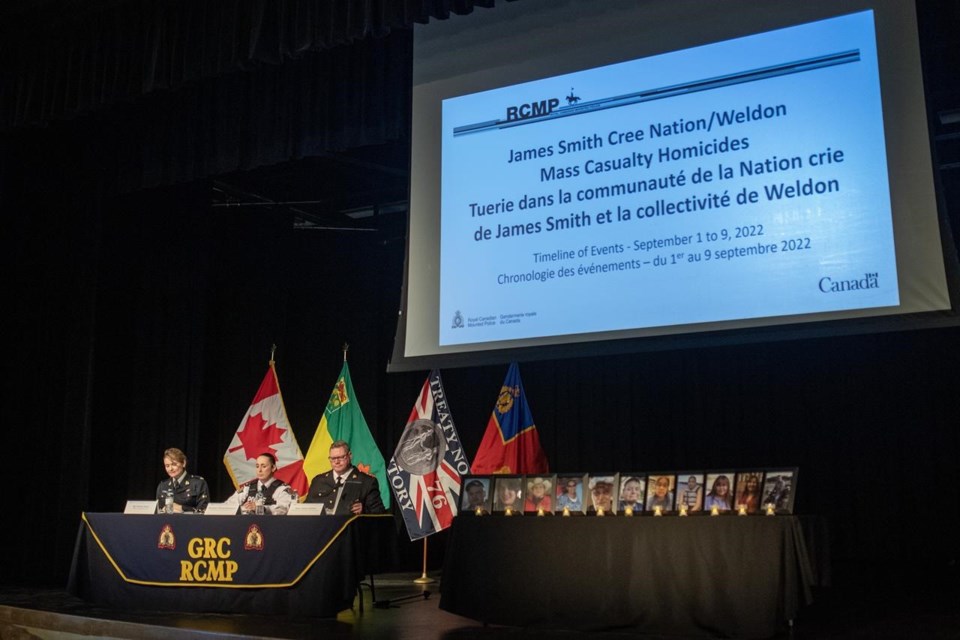MELFORT, Sask. — Mounties say the man accused of a deadly mass stabbing in Saskatchewan last year was selling drugs and causing havoc in the days before he drove throughout the First Nation and attacked and killed multiple people.
Mounties were releasing details Thursday about what happened on the James Smith Cree Nation and in the nearby village of Weldon on Sept. 4, when 11 people were killed and 18 were injured.
Myles Sanderson, the 32-year-old accused in the attacks, died in police custody a few days later.
Supt. Joshua Graham, the officer in charge of major crimes, said Myles Sanderson and his brother Damien Sanderson went to the First Nation to deal drugs on Sept. 1.
Throughout their time in the community, they attacked some residents and stole a vehicle. The day before the massacre, Damien Sanderson told people at a nearby bar they had a “mission to do” and that “people would hear all about it in the next few hours."
Damien Sanderson, however, was one of the first people killed the morning of the rampage.
After the brothers attacked a man in his home with scissors, Myles Sanderson and Damien Sanderson got into a fight in a vehicle. An injured Damien Sanderson fled the vehicle into the trees along the side of the road. His body would be located there the following day.
Myles Sanderson continued to go to different homes in the community, attacking some people and killing others. Other people he ominously threatened, saying they were lucky to not be hurt as he stole some of their vehicles.
Assistant Commissioner Rhonda Blackmore, commanding officer of the Saskatchewan RCMP, said the Mounties' probe into the rampage was incredibly complex and large scale.
Blackmore said she understands people have many questions about how the rampage could have happened.
"Some of those answers, unfortunately, may never be known," Blackmore said.
Blackmore said RCMP examined 42 different crime scenes, including buildings and vehicles. They also seized about 700 exhibits and spoke with more than 250 witnesses.
A handful of people from the community attended the presentation in Melfort, but victims and their families received the update on Wednesday.
Darryl Burns, whose sister Lydia Gloria Burns died in the stabbings, said it brought some closure.
"The way the morning went there was so much confusion, there was so much turmoil," Burns said. "Looking back on it, you couldn't really tell where he was going to go or what he was going to do."
He said there was a lot of emotion and "lot of the sorrow and sadness" hearing the timeline.
Mounties said the update won't affect two coroner's inquests set for early next year.
One of the inquests is to focus on the killings, while the other is to look at the suspect. Police have said Sanderson went into medical distress shortly after he was arrested near Rosthern, Sask.
An independent investigation is also being conducted by Saskatoon police and the Saskatchewan Serious Incident Response Team.
Mounties have previously released some details about the deadly rampage on the First Nation about 170 kilometres northeast of Saskatoon.
Four dangerous persons alerts were released before 10 a.m. saying there had been multiple victims and giving descriptions of the suspects and the vehicle in which they were believed to be travelling.
Later that day, Mounties announced multiple people had died or were injured in the attacks, which took place across 13 locations.
The province was on edge and police remained on the lookout for days, with sightings of Sanderson reported in Regina and back on the First Nation.
By Sept. 7, there was a break in the case. A 911 call came from the town of Wakaw, about 110 kilometres southwest of the First Nation, about a stolen white truck. Police vehicles sped down rural roads in the area and a helicopter hovered overhead.
The suspect vehicle hit a ditch and drove into trees along the highway near Rosthern. Sanderson was taken into police custody but went into medical distress shortly after and died.
The stabbings have amplified calls for more Indigenous-led policing. In response, federal Public Safety Minister Marco Mendicino signed an agreement with the Prince Albert Grand Council, which includes James Smith Cree Nation, to explore new ways to improve safety on some First Nations in the province.
James Smith Cree Nation Chief Wally Burns has previously called for all levels of government to support the community in establishing its own police force.
This report by The Canadian Press was first published April 27, 2023.
Kelly Geraldine Malone, The Canadian Press



